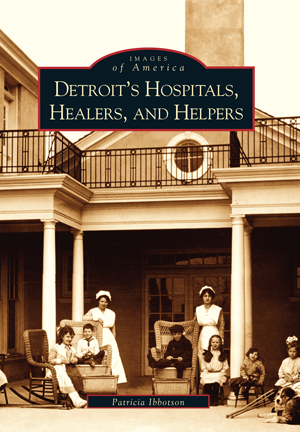
Like most communities in the country, Detroit hasn’t escaped the touch of novel coronavirus COVID-19. But looking at history, we see outstanding stories of heroism and bravery in the face of unspeakable tragedy and danger, and the stories of Detroit’s healthcare providers is no different. This story is the first in our new series, Heroes of Healthcare.

This story was adapted from the pictorial history by Patricia Ibbotso, Detroit’s Hospitals, Healers, and Helpers.
In the Beginning
The history of hospitals in Michigan dates back to the care provided to sick men in Michigan’s early military garrisons. The logbook of Captain Alex Harrison, of the Gage, a boat that was unloading at the Detroit wharf, included this story: “October 11, 1785. One hand sent to the hospital October 14. Durett came on board in place of Butler, gone to the hospital.” A report of June 24, 1790, describes the garrison hospital as one room equipped with 21 single berths and a single chimney.
In 1933 a general hospital was established here, and this complex grew to accommodate 10,000 patients, later becoming Wayne County General Hospital and Infirmary in 1945.

Eloise Sanitarium
Many hospitals were founded to meet specific needs, such as those to care for contagious diseases, such as tuberculosis, which was the leading cause of death at the turn of the century. Among them are the Detroit Tuberculosis Sanitarium (better known as the William H. Maybury Sanitarium), Herman Kiefer Hospital, Boulevard Sanitarium, and the Eloise Sanitarium. Other communicable diseases that were common were smallpox, cholera, diphtheria, and polio.
You may also be interested in: The Centers for Disease Control & Prevention (CDC): A Brief History
Eloise was among the first, if not the first, hospital to use x-rays to diagnose patients. The Infirmary Building had an x-ray machine, and patients came from Detroit and other communities to have x-rays taken.

The Visiting Nurse Association of Detroit
The Visiting Nurse Association of Detroit, founded in 1898, provided care in both clinics and patients’ homes. In addition to providing care to patients, several early hospitals established schools of nursing and other training programs for radiology and laboratory personnel. Before the establishment of these training programs, the patient’s family or the doctor’s or preacher’s wife gave bedside care to patients. In addition to bricks and mortar, the core of early hospitals consisted of the people who founded and staffed them.
Related: The Ghost Whisperer of Jacktown, Michigan (via Crime Capsule)
The VNA was founded in 1898. The first tuberculosis clinic in Detroit was established in 1906 by the VNA in a partnership with the Detroit Board of Health.

Benevolent Societies
The benevolent societies filled the need to care for old people and orphans who had no other resources. These were usually church-based homes. In many cases, children were left here, not necessarily because they were orphans, but because their mothers had to work and the institution was used for room and board.


Detroit’s Hospitals, Healers, and Helpers by Patricia Ibbotso is available for purchase from Arcadia Publishing.

